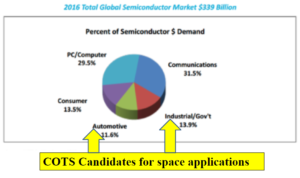COTS in Space
- Posted by Dan Friedlander
- On December 3, 2019
- 0
COTS Population
-
-
- The term “COTS” (Commercial Off-The-Shelf) refers to a huge EEE Components population, including all the commercial grade ones (industrial, commercial, consumers, automotive etc.).
- Referring to COTS, there should be no place for hasty generalization.
- Quote: “All generalizations are false, including this one.” – Mark Twain.
-

COTS Characteristics
-
-
- High Volume Production ensure efficiency of using statistical tools.
- Statistical Process Control (SPC) used in production line to prevent defects, translated into reliability.
- Better lot homogeneity, higher the value of sampling.
- No screening.
-
Global Developments
-
-
- Decrease of Military/Space Components market today to 0.1% of the world market (in dollars) from 60% in the 1960.
- Components Availability are dictated by manufacturers’ decisions based on market demand.
- Huge Technological Progress in solving reliability issues encountered in the last four decades.
-
Global Developments Impact
GLOBAL DEVELOPMENTS
lead to Cultural Change from
Use of Space/Military EEE Components
to
Use of Commercial EEE Components
1994 Perry memo
-
-
- 1994 Perry’s memo legalizes the use of COTS in military applications.
- Space applications are exempted.
- Main drivers:
-
-
-
-
- Defense Budget shrinking.
- Military components shrinking availability.
- Need for advanced technologies.
-
-
-
-
- The memo states “The use of military specifications and standards is authorized as a last resort, with an appropriate waiver”.
- The reversed components selection priority order is clear.
- It is big step to recognize officially the global developments, in an atmosphere of strong resistance to change.
-
REMEMBER
-
-
- The transition to COTS has a big potential for cost savings in military applications.
- The cost savings are realized with COTS used as is.
- For space applications the COTS are not used as is.
- The transition to COTS has a big potential for cost savings in military applications.
-
Methodology Change
-
-
- The global developments lead to the need for a new methodology adapted to deal with COTS for military projects. The space applications were exempted from 1994 Perry’s directive.
- The EEE Components Selection Policy has been changed to COTS becoming first priority selection
- A 20 years retrospective summary of properly selected COTS use across various military (air, ground, sea) and space applications (LEO) proves that COTS are OK.
-
MIL-PRF/QML Methodology
-
-
- Liberalized methodology following 1994 Perry’s directive.
- Transition from MIL-SPEC cookbook “how to” specifications to performance specifications.
- Transition from component level QPL to product line level QML.
- Components manufacturers get the authority to eliminate justified non-value added screening/ testing steps.
-
COTS
-
-
- Following 1994 Perry’s directive Commercial Off-The-Shelf (COTS) has been legalized for use in military applications.
- COTS dominate the global market (99.7% in $).
- Market Size = Incentive to invest in technological developments.
- High Volume Production = Valued Statistical Tools in Process Control = Reliability.
- Most failures are due to component manufacturing defects.
-
COTS in Space Official Policy
-
-
- The main leading COTS in space policy documents:
- NASA PEM-INST-001 (June 2003) – Instructions for Plastic Encapsulated Microcircuit (PEM) Selection, Screening, and Qualification.
- ESA ECSS-Q-ST-60-13C (21 October 2013) – Space product assurance commercial electrical, electronic and electromechanical (EEE) components.
- NASA PEM-INST-001 (June 2003) – Instructions for Plastic Encapsulated Microcircuit (PEM) Selection, Screening, and Qualification.
- The main leading COTS in space policy documents:
-
-
-
- The traditional methodology of dealing with space/military grade EEE components has been extended (with some tailoring) to commercial EEE components.
- The policy imposes on the user a “last resort” a COTS selection path vs. preferred Space/MIL components.
- The selection of COTS is penalized.
-
COTS in Space Debunking Myths
- Myth 1:
Incorrect interpretation of the term “space qualified”.
-
-
- The environmental requirements to be met are various, depending on many parameters like orbit, mission criticality, mission duration, etc.
- The term “space qualified” shall be fully understood in context of the specific component specification and in context of the intended application.
- The term “space qualified” refers often to the component quality level, unless RHA is specified.
-
- Myth 2:
The main drive to use COTS in space is cost savings.-
- Compare apple to apple, namely component ownership cost.
- Component Ownership Cost = Component Pre-procurement Cost (NRE) + Component Procurement Cost (RE) + component Post Procurement Cost (NRE).
- The main drive: component availability to meet performance and/or Size, Weight, Power (SWaP).
-
- Myth 3:
Incorrect interpretation of the term “space heritage”.-
- Compare apple to apple, namely mission to mission.
- Space missions are various:
- Scope: scientific, in orbit demonstration, operational …
- Orbits: LEO, GEO.
- Mission duration: <1 year to 15 years.
-
- Myth 4:
Use of terms “quality” and “reliability” interchangeably.
-
-
- Quality and reliability are two terms referring to two entirely different aspects of the behavior of a component over its lifetime.
- Quality measures how well the facility produces components that meet the specifications at the start of use.
- Reliability is the probability of a component meeting the relevant specification over the lifetime.
-
- Myth 5:
COTS reliability cannot be ensured, unless they are 100 percent tested and screened.
-
-
- Reliability cannot be tested into the component.
- The qualification and screening are not considered as a substitute for manufacturing control, but rather as risk-mitigation measures.
- Process (design followed by manufacturing) builds reliability into the component.
- Statistical Process Control (SPC) addresses the reliability issue.
-
- Myth 6:
Meeting absolute quantitative limit of reliability is required in technical specifications in order to achieve the needed mission reliability.
-
-
- MIL-HDBK-217F explicitly states: “A reliability prediction should never be assumed to represent the expected field reliability”.
- As MIL-HDBK-217F admits, “those who view the prediction only as a number which must exceed a specified value can usually find the way to achieve their goal without any impact on the system”.
-
- Myth 7:
Plastic encapsulated semiconductors (PEM) cannot be used for space applications.
-
-
- The problems encountered in early stages (from the 1960s) with non-hermetic plastic encapsulated semiconductors caused the military and space components policymakers to taboo (avoid or ban) their use in military and space applications.
- If properly stored, there is no problem using non-hermetic components in space.
- In space there is no moisture.
-
- Myth 8:
COTS manufacturing is not controlled sufficiently.
-
-
- The history does not show that a central control has been efficient for military components.
- The military-level qualified components (widely used in space) and COTS have the same lack of wafer traceability problem.
- The space industry turns a blind eye on the lack of wafer traceability for traditionally accepted military level components, but penalizes COTS in space because of the same traceability issue!
-
- Myth 9:
Success in space missions can be achieved only by means of a conservative approach.
-
-
- Space missions are inherently risky.
- No approach, not even a conservative one, can avoid failures.
- The name of the game is risk management.
- Today, there is enough proof (see U.S. private space industry) that progressing with a more liberal approach is a valid way to success.
-
- Myth 10:
Redundancy is a magic solution to enable the use of softer radiation components.
-
-
- Redundancy, if found necessary, is a good practical solution for lowering the probability of system failures.
- The same type of components are expected to fail independently in the same design.
- This may be outweighed by other risk factors, such as human design error, generic failure modes, etc.
- True redundancy: implementation with different designs designed by different teams.
-
COTS in Space – The Future Input to Forecast
- Input Data for the Forecast:
-
-
- The traditional MIL methodology for space and military applications, based on heavy testing/screening of hermetically sealed electronic components, is deeply rooted in the ongoing environment of resistance to change.
- EEE COTS components, in spite of huge technological developments, were banned for decades to be used in military and space applications.
-
- The MIL traditional methodology rigidity and the commercial market dominance lead to a considerable technological lag of military/space EEE components behind commercial ones.
- The military/space EEE components market size led to components manufacturers business decisions to leave the military/space market, further affecting the availability.
- It has been proven that components manufacturers are independent in taking business decisions.
- Budgets are shrinking.
-
-
- After long debates the US DoD officially was compelled (by global developments) to recognize the legitimacy of usage of EEE COTS components in military applications.
- The decision to use of EEE COTS components in military applications has been proved as a successful one from every aspect.
-
- The above decision has led to replacing the MIL traditional methodology with the QML concept, a liberalized version of the traditional one, infused with elements of commercial practices.
- The space applications have been exempted (DoD is not responsible for space) from the above decision.
- Meanwhile, within local initiatives, EEE COTS components were successfully used in space applications.
- Extremely slow space policy makers decision taking led to a last resort EEE COTS components penalized methodology.
- The present space policy leads to preference of military/space grade, hermetically sealed EEE components in space applications.
-
The only thing certain about the availability security of the military/space EEE components is uncertainty.
-
COTS in Space – Forecast
-
-
- It is obvious that without electronics the space industry cannot survive. Consequently, the availability of the electronic components is a MUST.
- Presently, most of the space designs are based on military/space grade hermetically sealed electronic components, meeting the space agencies’ policies.
- The direct consequence is to commit those designs to insecure components availability.
- The availability of military/space grade EEE Components depends solely on business decisions By Components Manufacturers, based on a miniscule space demand (less than 0.3% in $).
- The business minded movement of the semiconductor industry to economy of scale cannot be stopped.
- Not profitable markets will disappear.
- Like for military, COTS in space is considered a viable disruptive alternative.
- The policy makers’ duty should be to lead proactively the industry into the future.
They have to adapt to the NewSpace philosophy, otherwise they may become irrelevant. - New thinking is urgently needed to accelerate new policy creation efforts.
- It is obvious that without electronics the space industry cannot survive. Consequently, the availability of the electronic components is a MUST.
-
COTS in Space Official Methodology To be changed
Albert Einstein wrote: “We cannot solve our problems with the same thinking we used when we created them”.

Latest posts by Dan Friedlander (see all)
- Talking On COTS For Space With Dan Friedlander. Episode 10: Pragmatic Policy Wanted - May 16, 2024
- Talking on COTS for space with Dan Friedlander. Episode 8: Policy making progress - January 16, 2024
- Talking on COTS for space with Dan Friedlander. Episode 7: RHA Component vs Product - November 20, 2023


0 comments on COTS in Space